
The Cucurbitaceae, also called cucurbits or the gourd family, are a plant family consisting of about 965 species in around 95 genera. Those most important to humans are the following:
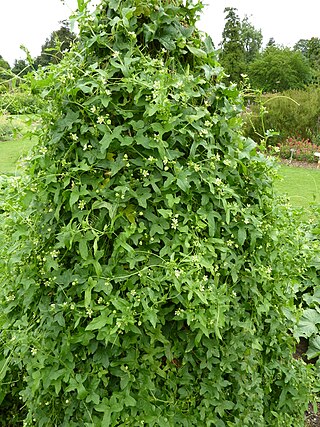
Bryonia is a genus of flowering plants in the gourd family. Bryony is its best-known common name. They are native to western Eurasia and adjacent regions, such as North Africa, the Canary Islands and South Asia.

Xerosicyos is a flowering plant genus of the family Cucurbitaceae. Its name comes from Greek xeros and sicyos ("cucumber"). There are three species, all endemic to Madagascar. Xerosicyos danguyi is a large liana with thick stems and round, gray succulent leaves. It is common in cultivation and often called the "silver dollar" vine. Xerosicyos perrieri is also a liana with thinner stems and smaller, ovate green succulent leaves. Xerosicyos pubescens is entirely different from the previous species. It forms a large caudex from which deciduous vines emerge. The leaves are lobed and semi-succulent and die back in the dry season and during prolonged periods of drought.

Sicyos angulatus, the oneseed bur cucumber or star-cucumber is an annual vine in the gourd family, Cucurbitaceae, native to eastern North America. The plant forms mats or climbs using tendrils. The leaves are palmately veined and lobed, the flowers are green to yellowish green, and the fruits form clusters of very small pepos.

Melothria scabra, commonly known as the cucamelon, Mexican miniature watermelon, Mexican sour cucumber, Mexican sour gherkin, mouse melon, or pepquinos, is a species of flowering plant in the cucurbit family grown for its edible fruit. Its native range spans Mexico to Venezuela. Cucumis melo Agrestis and Cucumis callosus is cultivated as Chibber Fruit or Kachri in South Asia and can also grow as weed. Fruits are about the size of grapes and taste like cucumbers with a tinge of sourness. It may have been eaten by indigenous peoples before the European colonization of the Americas began.

Hydnora africana is an achlorophyllous plant in the subfamily Hydnoroideae, native to southern Africa that is parasitic on the roots of members of the family Euphorbiaceae. It is also called jakkalskos or jackal food. The specific epithet africana means to be from Africa. Molecular data has suggested that Hydnoroideae is a "basal angiosperm" solidifying its place among the more primitive flowering plants. Hydnoraceae are the only angiosperms known to have no leaves or scales and are considered obligate parasites, completely dependent on their hosts to survive. The plant grows underground, except for a fleshy flower that emerges above ground and emits an odour of faeces to attract its natural pollinators, dung beetles and carrion beetles. The vegetative body of the plants has been reduced to only consisting of roots and flowers. The flowers act as temporary traps, retaining the beetles that enter long enough for them to pick up pollen.

Cotyledon tomentosa is a species of flowering plant in the family Crassulaceae, native to South Africa. It is a succulent evergreen shrub with large chunky ovate fuzzy green leaves. Its autonymous subspecies is known as the bear's paw because of the prominent "teeth" at the tips of its leaves. It forms large orange bell-shaped flowers in spring. In its native habitat, the Little Karoo region of South Africa, Cotyledons usually grow in rocky quartz fields where they have excellent drainage provided by very porous soil.
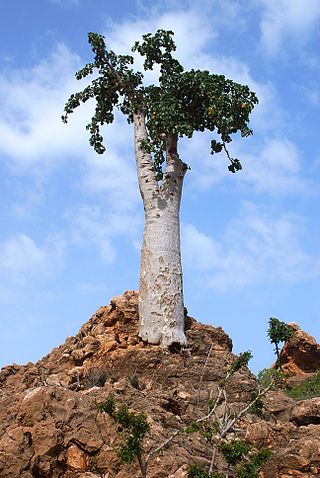
Dendrosicyos is a monotypic genus in the plant family Cucurbitaceae. The only species is Dendrosicyos socotranus, the cucumber tree. The species is endemic to the island of Socotra in Yemen, and is the only species in the Cucurbitaceae to grow in a tree form. The species name was originally spelled D. socotrana, but this is corrected to masculine grammatical gender according to the International Code of Nomenclature for algae, fungi, and plants.
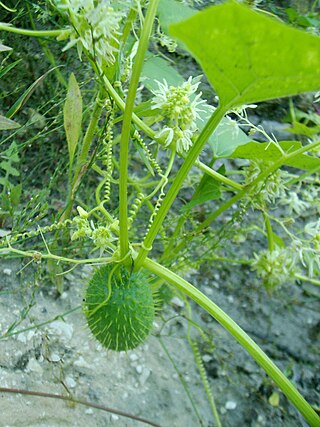
Echinocystis is a monotypic genus in the gourd family, Cucurbitaceae. The sole species is E. lobata, commonly called wild cucumber, prickly cucumber or bur cucumber. It is an annual, sprawling plant that is native to North America.
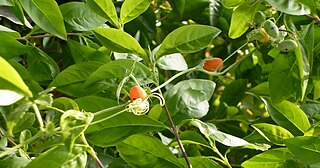
Ctenolepis garcini, also known as Garcin's bur cucumber, is a tender climber of the family Cucurbitaceae. It is one of the three species of the genus Ctenolepis. It is widely distributed in South India and Ceylon. The species was named after French botanist Laurent Garcin, who traveled India in the 18th century.

Guthriea capensis is an acaulescent perennial herb endemic to South Africa and occurring in cool and damp sites facing south or east in the mountains of the Cape Province, Lesotho and KwaZulu-Natal. Guthriea is monotypic and was named after the botanist and mathematician Francis Guthrie by his friend the botanist Harry Bolus.

Kedrostis is a genus of ± 35 species climbing or trailing herbs in the family Cucurbitaceae. Its native range is tropical Africa and Asia.

Cola greenwayi, commonly known as hairy cola or Zulu coshwood, is a species of flowering plant in the family Malvaceae. It was first described in 1956 by the British botanist John Patrick Micklethwait Brenan. It is native to southeastern Africa.

Constance Georgina Adams, also known as Constance Georgina Tardrew, was a South African housewife and collector of botanical specimens. Known by the nicknames Connie and Daisy, Adams was born in Cape Town and spent her early childhood on a farm in Tulbagh before moving to Warrenton. She subsequently lived in Kimberley before getting married, settling in Johannesburg where she became active in the Housewives League of South Africa. Inspired by her parents' interest in botany, she became a successful collector for both the Albany Museum in Grahamstown and McGregor Museum in Kimberley. She also cultivated a friendship with the Director of the latter, Maria Wilman. She collected over 240 specimens, which were presented to the Albany Museum, McGregor Museum and the National Herbarium in Pretoria.

Jatropha moranii is a very rare subshrub in the genus Jatropha known commonly as Moran's lomboy. This species in the family Euphorbiaceae is endemic to a small area of Cabo San Lucas in Baja California Sur. It is characterized by a succulent stem and branches, along with a distinct woody caudex, and attractive white flowers.

Tylecodon paniculatus, also known as butter bush, butter tree, butterboom or rooisuikerblom (Afrikaans), is a species of succulent plant in the genus Tylecodon belonging to the family Crassulaceae.

Babiana hirsuta is a species of geophyte of 40–70 cm (16–28 in) high that is assigned to the family Iridaceae. It has many scarlet mirror-symmetrical flowers in a branched inflorescence with several short ascending branches. The flower has a narrow tube, and three large, blackish or dark purple anthers that extend beyond the dorsal tepal. The leaves are velvety hairy, lance-shaped, laterally compressed and set in a fan. It is an endemic species of South Africa that can be found along the west coast of the Northern and Western Cape provinces as far south as Saldanha. It is called red babiana in English, but that name is also applied to Babiana villosa, and strandlelie, sandlelie and rooihanekam in Afrikaans. Until 2008, the strandlelie was known as Babiana thunbergii.
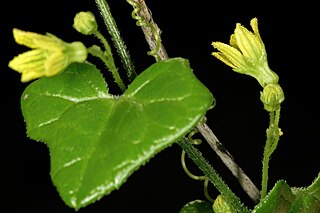
Kedrostis nana is a species of flowering plant in the family Cucurbitaceae, indigenous to scrub vegetation in the coastal areas of South Africa, from Saldanha in the west, along the coast as far east as KwaZulu-Natal.

Kedrostis capensis is a species of flowering plant in the family Cucurbitaceae, indigenous to rocky, karoo slopes in South Africa and Namibia.


















